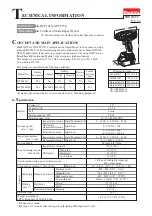
15
14
model no. 054-1264-8 | contact us 1.800.689.9928
IMPACTING TIPS
The proper fastening torque may differ depending on the type or size of the
bolt, the material of the workpiece to be fastened, etc.
Hold the tool firmly, and place the socket over the bolt or nut. Turn the tool on,
and fasten the bolt or nut to the proper torque.
Practice with various fasteners, noting the length of time required to reach the
desired torque. Check the tightness with a hand torque wrench. If the fasteners
are too tight, reduce the impacting time. If they are not tight enough, increase
the impacting time. The torque that is required to loosen a fastener averages
75% to 80% of the tightening torque, depending on the condition of the
contacting surfaces. However, if rust or corrosion causes seizing, more torque
may be required.
After fastening, always check the torque with a torque wrench. The fastening
torque is affected by a wide variety of factors, including the following:
1. Voltage
• A voltage reduction will cause a reduction in the fastening torque.
2. Socket
• Failure to use the correct size socket will cause a reduction in the fastening
torque.
• A worn socket (wear on the hex end or square end) will cause a reduction in
the fastening torque.
3. Bolt
• Although the torque coefficient and the class of bolt may be the same, the
proper fastening torque will differ according to the diameter of the bolt.
• Although the diameters of bolts are the same, the proper fastening torque
will differ according to the torque coefficient, the class of bolt and the bolt
length.
4. The use of a universal joint or an extension bar (both available separately) will
reduce the fastening force of the impact wrench somewhat. Compensate by
fastening for a longer period of time.
5. The manner of holding the tool or the material to be fastened will affect the
torque.
MAINTeNANCe
befORe eACh USe:
• Inspect the impact wrench, the switch, and the cord for damage.
• Check for damaged, missing, or worn parts.
• Check for loose screws, misalignment or binding of moving parts, or any other
condition that may affect the operation.
• If abnormal vibration or noise occurs, turn the impact wrench off immediately,
and have the problem corrected before further use.
• Using compressed air may be the most effective cleaning method. Always wear
safety goggles when cleaning tools using compressed air.
O
P
e
R
A
TING
INS
TRUCTIONS
MAINT
e
NANC
e
NOTe:
• Hold the tool straight along the axis of the bolt or nut.
• Excessive fastening torque may damage the bolt/nut or socket. Before
starting your job, always perform a test operation to determine the proper
fastening time for your bolt or nut.
WARNING!
• To ensure safety and reliability, all repairs should be performed
by a qualified service technician.
• When servicing, use only identical replacement parts. The use
of any other parts may create a hazard or cause damage to the
product.
• Unplug the impact wrench from the power source before
cleaning or performing any maintenance.
• Do not allow brake fluids, gasoline, petroleum-based products,
penetrating oil, etc. to come into contact with plastic parts.
These substances contain chemicals that can damage, weaken,
or destroy plastic.
FPO



























